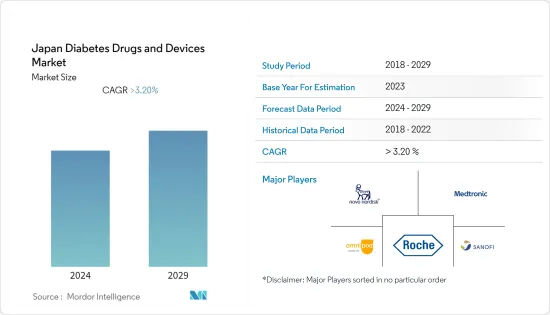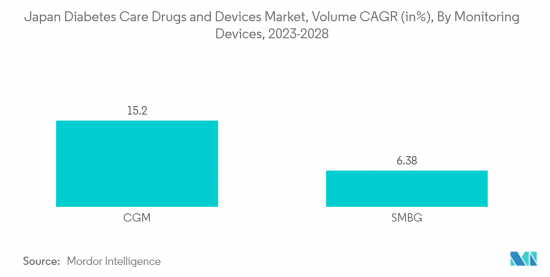 |
市場調査レポート
商品コード
1408323
日本の糖尿病治療薬・機器:市場シェア分析、産業動向と統計、2024年~2029年の成長予測Japan Diabetes Drugs and Devices - Market Share Analysis, Industry Trends & Statistics, Growth Forecasts 2024 - 2029 |
||||||
● お客様のご希望に応じて、既存データの加工や未掲載情報(例:国別セグメント)の追加などの対応が可能です。 詳細はお問い合わせください。
| 日本の糖尿病治療薬・機器:市場シェア分析、産業動向と統計、2024年~2029年の成長予測 |
|
出版日: 2024年01月04日
発行: Mordor Intelligence
ページ情報: 英文 70 Pages
納期: 2~3営業日
|
- 全表示
- 概要
- 目次
日本の糖尿病治療薬・機器市場規模は、今年度115億米ドルと推定されます。
予測期間中のCAGRは3.2%以上で、5年後には135億米ドルに達すると予想されます。

COVID-19の流行は糖尿病治療薬市場に大きな影響を与えています。COVID-19で入院した患者に糖尿病が蔓延し、血糖コントロールの改善によりSARS-CoV-2患者の転帰が改善し入院期間が短縮される可能性が認識されたため、糖尿病治療機器の重要性が強調されています。米国糖尿病学会(ADA)の第81回仮想学術集会では、日本人におけるCOVID-19感染の重症化を加速させる主要な危険因子が糖尿病であることがレトロスペクティブ解析で示されました。
糖尿病はパンデミックの間中、COVID-19の主要な危険因子であり続けた。免疫系の機能不全が1型糖尿病を引き起こすのに対し、2型糖尿病は先天性インスリン抵抗性につながる座りがちな生活習慣と関連しています。従って、1型糖尿病はインスリン依存性糖尿病として、2型糖尿病はインスリン依存性糖尿病として特徴づけられます。日本は世界でも有数の高齢者人口を抱え、2型糖尿病を発症しやすいです。日本では高齢化が進み、糖尿病の有病率が増加しています。心血管疾患や腎臓病などの悪影響を避けるため、血糖値の監視・管理がますます厳しくなっています。
したがって、上記の要因は予測期間中の市場成長を促進すると予想されます。
日本の糖尿病治療薬と機器市場動向
予測期間中、持続グルコースモニタリングセグメントが最も高い成長率を示す見込み
持続グルコースモニタリングセグメントは、予測期間中にCAGR 11%以上を記録する見込みです。
連続グルコースモニタリングセンサーは、グルコースオキシダーゼを使用して血糖値を測定します。グルコースオキシダーゼはグルコースを水素ペルオキシダーゼに変換し、この水素ペルオキシダーゼがセンサー内のプラチナと反応して、トランスミッターに送られる電気信号を生成します。センサーは、持続血糖モニター装置において最も重要な部分です。研究開発者は、電気化学式グルコースセンサーに代わるCGMセンサーを見つけ、開発し、CGMセンサーをより手頃な価格で、侵襲が少なく、使いやすいものにしようとしています。光学測定はグルコース測定の有望なプラットフォームです。分光法、蛍光法、ホログラフィック法など、連続グルコース測定に高い可能性を持ついくつかの技術が報告されています。Sensonics社が開発した蛍光ベースのCGMセンサーであるEversenseは、電気化学センサーよりもはるかに寿命が長いです。センサーの精度を向上させる技術の進歩が、予測期間中のこのセグメントの成長を促進すると予想されます。CGMでは、皮膚の表層を貫通する小さなプラスチック製カニューレを使用して、小型センサーを腹部または腕に挿入します。粘着パッチがセンサーを固定し、昼夜を問わず間質液中のグルコースレベルを測定できます。一般に、センサーは7~14日ごとに交換する必要があります。センサーに取り付けられた再使用可能な小型トランスミッターにより、システムはリアルタイムの測定値を血糖値データを表示するモニターにワイヤレスで送信することができます。独自のモニターを持つシステムもあれば、スマートフォンのアプリを介して情報を表示するシステムもあります。
血糖値をモニターする頻度は、糖尿病のタイプによって異なり、患者ごとに異なります。1型糖尿病の患者は、定期的なチェックで血糖値をモニターし、それに応じてインスリンの投与量を調整する必要があります。彼のCGM機器は現在、設定された間隔で定期的に血糖モニタリングを行うのと比較して、血糖値のパターンや動向を詳細に示しています。さらに、現在の持続血糖モニターは、データをダウンロードしたり、受信機のディスプレイを介して血糖値のリアルタイム画像を提供したりすることで、血糖値の動向を遡ってチェックすることができます。携帯電話との統合のような新技術により、持続血糖モニターはますます手頃な価格になってきています。このことは、予測期間中、このセグメントの成長を促進すると思われます。

糖尿病有病率の上昇
糖尿病は厚生労働省によって重要な健康問題に分類されています。2型糖尿病の高い有病率は、大きな経済的負担を伴う。高血圧や高脂血症などの合併症を持つ患者や合併症を発症した患者では、糖尿病のコストは増加します。合併症の数が増えれば価格も上がります。日本では健康保険制度が発達しており、糖尿病の医療費は全額負担され、糖尿病患者は無料で受診することができます。インスリン自己注射療法も法制化され、健康保険が適用されています。このような利点から、これらの製品が日本市場に導入されています。
経口糖尿病治療薬は世界中で入手可能であり、生活習慣の管理や2型糖尿病治療の拡大が必要な場合に使用することが推奨されています。経口剤は、有効性、安全性、作用機序が多岐にわたるため、通常、2型糖尿病治療の第一選択薬となっています。抗糖尿病薬は、糖尿病患者の病状をコントロールし、糖尿病合併症のリスクを軽減するのに役立ちます。糖尿病患者は、血糖値をコントロールし、低血糖や高血糖を避けるために、生涯にわたって抗糖尿病薬を服用する必要があります。経口血糖降下薬は使いやすく、安価であるという利点があります。そのため、インスリンに代わる魅力的な治療薬として受け入れられ、服薬アドヒアランスの向上につながっています。日本では、肥満人口の増加、不健康な食生活、座りっぱなしのライフスタイルなどにより、糖尿病の有病率はすべての年齢層で増加しています。糖尿病は、その高い有病率と、臨床システム、個人、政府に対する経済的負担の増大により、重大な懸念事項となっています。日本の医療システムには、日本糖尿病教育・ケア協会が運営するいくつかの疾病管理プログラムがあります。日本は、糖尿病患者のための公衆衛生政策に関して、アジア太平洋のリーダーの一人です。同国は国民の意識を高め、成人発症糖尿病の可能性を減らすことができるライフスタイルや食生活の変化に焦点を当てた予防策を実施しています。
糖尿病有病率の増加と上記の要因が、予測期間中の同分野の成長を牽引すると思われます。
日本の糖尿病治療薬・機器産業概要
AbbottやMedtronicのような大企業は、有機的成長戦略を堅持する一方で、市場支配力を獲得するために数多くの合併、買収、提携を行ってきました。インスリン送達機器のメーカーは、機器の研究開発に巨額を費やしています。例えば、Novo NordiskはAbbott Diabetes Careと提携し、Novo Nordiskと接続されたインスリン・ペンとFreeStyle Libreの製品ポートフォリオに適したデジタルフィットネス機器との間でインスリン統計を共有できるよう支援する可能性もあります。
その他の特典:
- エクセル形式の市場予測(ME)シート
- 3ヶ月間のアナリストサポート
目次
第1章 イントロダクション
- 調査の前提条件と市場定義
- 調査範囲
第2章 調査手法
第3章 エグゼクティブサマリー
第4章 市場力学
- 市場概要
- 市場力学
- 市場促進要因
- 市場抑制要因
- ポーターのファイブフォース分析
- 供給企業の交渉力
- 消費者の交渉力
- 新規参入業者の脅威
- 代替品の脅威
- 競争企業間の敵対関係の強さ
第5章 市場セグメンテーション(市場規模-米ドル)
- 機器
- モニタリング機器
- 自己血糖モニタリング機器
- 持続血糖モニタリング機器
- 管理機器
- インスリンポンプ
- インスリンシリンジ
- インスリンカートリッジ
- 使い捨てペン
- モニタリング機器
- 薬剤
- 経口糖尿病治療薬
- インスリン製剤
- 配合剤
- 非インスリン注射薬
第6章 市場指標
- 1型糖尿病人口
- 2型糖尿病人口
第7章 競合情勢
- 企業プロファイル
- Novo Nordisk
- Medtronic
- Insulet
- Tandem
- Ypsomed
- Novartis
- Sanofi
- Eli Lilly
- Abbottt
- Roche
- Astrazeneca
- Dexcom
- Pfizer
- 企業シェア分析
第8章 市場機会と今後の動向

Japan's Diabetes Care Drugs and Devices Market size is estimated at USD 11.5 billion in the current year. The market is expected to reach USD 13.5 billion in five years, registering a CAGR of more than 3.2% during the forecast period.
The COVID-19 pandemic has had a significant impact on the diabetes drug market. Due to the prevalence of diabetes in patients hospitalized with COVID-19 and the recognition that improved glycemic control may improve outcomes and shorten hospital stays in patients with SARS-CoV-2, diabetes treatment The importance of equipment is emphasized. At the American Diabetes Association's (ADA) 81st Virtual Scientific Meeting, a retrospective analysis showed that diabetes is the leading risk factor for accelerated severity of COVID-19 infection among Japanese.
Diabetes remained a major risk factor for COVID-19 throughout the pandemic. A malfunction of the immune system causes type 1 diabetes, whereas type 2 diabetes is associated with a sedentary lifestyle, leading to congenital insulin resistance. Therefore, type 1 diabetes can be characterized as insulin-dependent diabetes, and type 2 diabetes can be characterized as insulin-dependent diabetes. Japan has one of the largest elderly populations in the world and is more prone to developing type 2 diabetes. In Japan, the population is aging, and the prevalence of diabetes is increasing. Blood sugar levels are increasingly monitored and controlled to avoid adverse effects such as cardiovascular disease, kidney disease, etc.
Thus, the above factors are expected to drive market growth over the forecast period.
Japan Diabetes Drugs and Devices Market Trends
The continuous Glucose Monitoring Segment is Expected to Witness the Highest Growth Rate Over the Forecast Period
The continuous glucose monitoring segment is expected to register a CAGR of more than 11% over the forecast period.
Continuous glucose monitoring sensors use glucose oxidase to measure blood sugar levels. Glucose oxidase converts glucose to hydrogen peroxidase, which reacts with platinum in the sensor to produce an electrical signal sent to a transmitter. The sensor is the most important part of any continuous blood glucose monitoring device. Researchers seek to find and develop alternatives to electrochemical glucose sensors to make CGM sensors more affordable, minimally invasive, and user-friendly. Optical measurement is a promising platform for glucose measurement. Several techniques with high potential for continuous glucose measurement have been reported, including spectroscopy, fluorescence, and holographic techniques. Eversense, a fluorescence based CGM sensor developed by Sensonics Company, has a much longer lifetime than electrochemical sensors. Technological advances in improving sensor accuracy are expected to drive the growth of the segment during the forecast period. With CGM, a small sensor is inserted into the abdomen or arm using a small plastic cannula that penetrates the top layer of the skin. An adhesive patch holds the sensor in place, allowing it to measure glucose levels in interstitial fluid day and night. In general, the sensor should be replaced every 7-14 days. A small, reusable transmitter attached to the sensor allows the system to wirelessly transmit real-time readings to a monitor displaying blood glucose data. Some systems have their own monitor, while others show information via smartphone apps.
The frequency of monitoring blood glucose levels depends on the type of diabetes and is different for each patient. Patients with type 1 diabetes should monitor their blood sugar levels with regular checks and adjust their insulin dosage accordingly. His CGM device now details blood glucose patterns and trends compared to routine blood glucose monitoring at set intervals. In addition, current continuous blood glucose monitors can retroactively check blood glucose trends by downloading data or providing real-time images of blood glucose levels via the receiver display. New technologies like cell phone integration make continuous glucose monitoring devices increasingly affordable. This is likely to drive the growth of the segment during the forecast period.

Rising diabetes prevalence
Diabetes is classified as an important health problem by the Ministry of Health, Labor and Welfare. The high prevalence of type 2 diabetes comes with a significant economic burden. The cost of diabetes increases in patients with comorbidities such as hypertension and hyperlipidemia and those who develop complications. As the number of complications increases, so does the price. In Japan, a well-developed health insurance system covers all medical expenses for diabetes, and people with diabetes can see a doctor for free. Insulin self-injection therapy has also been legalized and covered by health insurance companies. These advantages have led to introducing of these products into the Japanese market.
Oral antidiabetic agents are available worldwide and are recommended for use when lifestyle management and escalation of type 2 diabetes treatment are required. Oral formulations are usually the drugs of first choice for the treatment of type 2 diabetes because of their wide range of efficacy, safety, and mechanisms of action. Antidiabetic drugs help people with diabetes control their condition and reduce the risk of diabetic complications. People with diabetes may need to take antidiabetic drugs throughout their lives to control blood sugar levels and avoid hypoglycemia or hyperglycemia. Oral hypoglycemic agents have the advantage of being easy to use and inexpensive. This has made them an attractive alternative to insulin, leading to greater acceptance and improved adherence. In Japan, the prevalence of diabetes is increasing in all age groups due to a growing obese population, unhealthy diets, and sedentary lifestyles. Diabetes is a significant concern due to its high prevalence and increasing financial burden on clinical systems, individuals, and governments. The Japanese healthcare system includes several disease control programs run by the Japan Diabetes Education and Care Association. Japan is one of the leaders in the Asia-Pacific region when it comes to public health policy for people with diabetes. The country is raising public awareness and implementing preventive measures focused on lifestyle and dietary changes that can reduce the likelihood of adult-onset diabetes.
The increasing diabetes prevalence and the above factors will likely drive segment growth over the forecast period.
Japan Diabetes Drugs and Devices Industry Overview
Large companies such as Abbott and Medtronic have made numerous mergers, acquisitions, and partnerships to gain market dominance while adhering to organic growth strategies. The manufacturers of insulin delivery devices are spending a huge amount on the R&D of the devices. For example, Novo Nordisk partnered with Abbott Diabetes Care, which may also assist to enable insulin statistics to be shared between Novo Nordisk-connected insulin pens and digital fitness equipment well suited to the FreeStyle Libre portfolio of products.
Additional Benefits:
- The market estimate (ME) sheet in Excel format
- 3 months of analyst support
TABLE OF CONTENTS
1 INTRODUCTION
- 1.1 Study Assumptions and Market Definition
- 1.2 Scope of the Study
2 RESEARCH METHODOLOGY
3 EXECUTIVE SUMMARY
4 MARKET DYNAMICS
- 4.1 Market Overview
- 4.2 Market Dynamics
- 4.2.1 Market Drivers
- 4.2.2 Market Restraints
- 4.3 Porter's Five Forces Analysis
- 4.3.1 Bargaining Power of Suppliers
- 4.3.2 Bargaining Power of Consumers
- 4.3.3 Threat of New Entrants
- 4.3.4 Threat of Substitute Products and Services
- 4.3.5 Intensity of Competitive Rivalry
5 Market Segmentation (Market Size by Value - USD)
- 5.1 Devices
- 5.1.1 Monitoring Devices
- 5.1.1.1 Self-monitoring Blood Glucose Devices
- 5.1.1.2 Continuous Blood Glucose Monitoring
- 5.1.2 Management Devices
- 5.1.2.1 Insulin Pump
- 5.1.2.2 Insulin Syringes
- 5.1.2.3 Insulin Cartridges
- 5.1.2.4 Disposable Pens
- 5.1.1 Monitoring Devices
- 5.2 Drugs
- 5.2.1 Oral Anti-Diabetes Drugs
- 5.2.2 Insulin Drugs
- 5.2.3 Combination Drugs
- 5.2.4 Non-Insulin Injectable Drugs
6 Market Indicators
- 6.1 Type-1 Diabetes Population
- 6.2 Type-2 Diabetes Population
7 COMPETITIVE LANDSCAPE
- 7.1 Company Profiles
- 7.1.1 Novo Nordisk
- 7.1.2 Medtronic
- 7.1.3 Insulet
- 7.1.4 Tandem
- 7.1.5 Ypsomed
- 7.1.6 Novartis
- 7.1.7 Sanofi
- 7.1.8 Eli Lilly
- 7.1.9 Abbottt
- 7.1.10 Roche
- 7.1.11 Astrazeneca
- 7.1.12 Dexcom
- 7.1.13 Pfizer
- 7.2 Company Share Analysis
